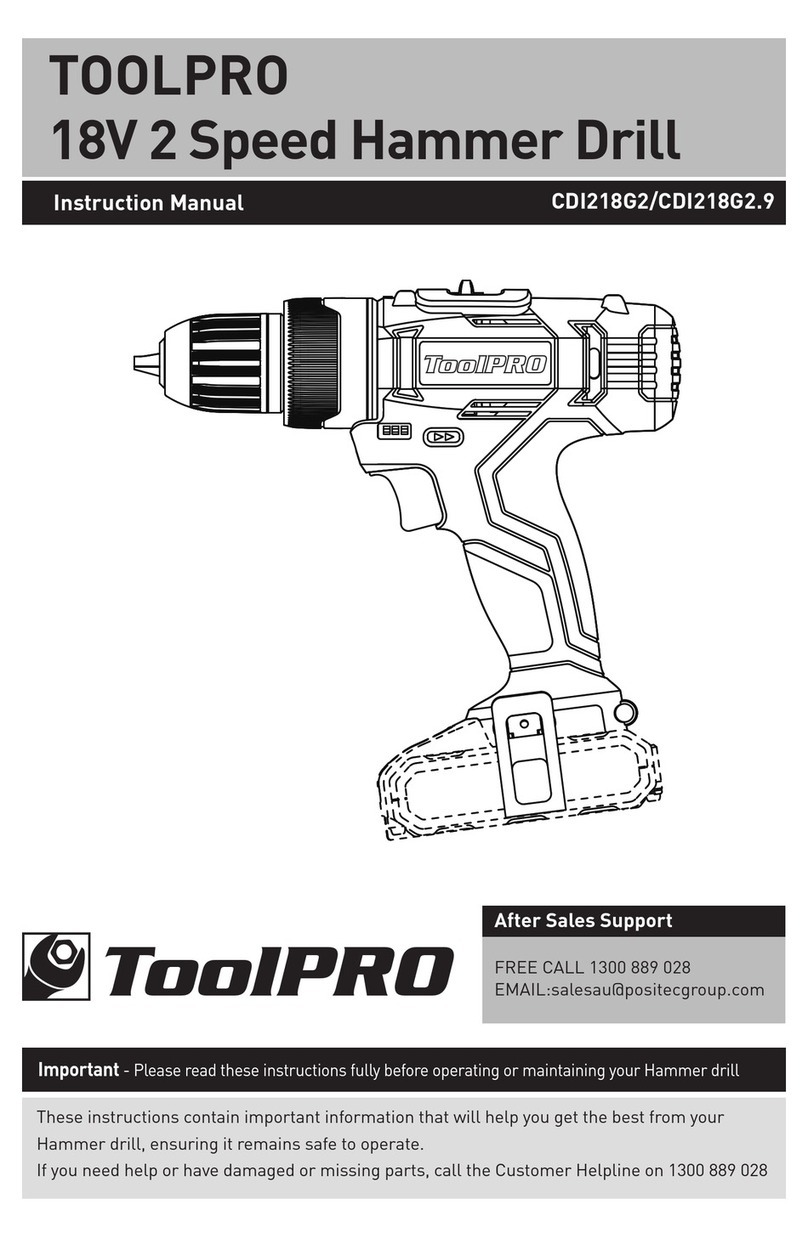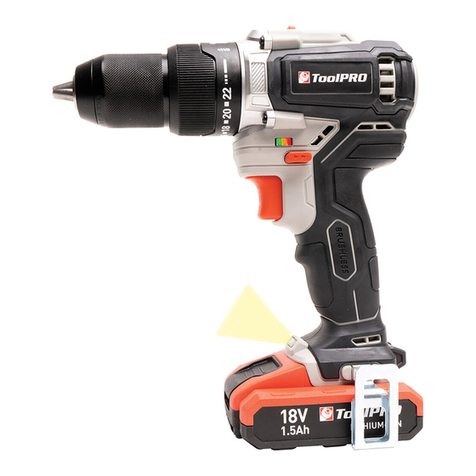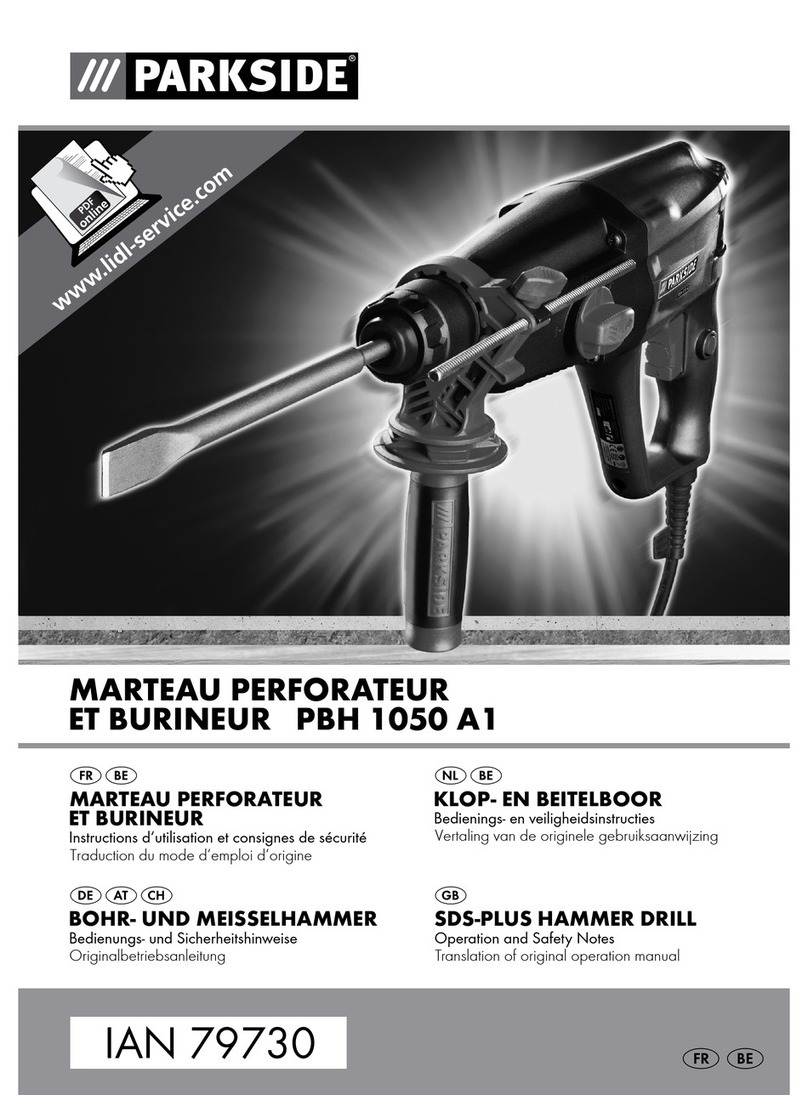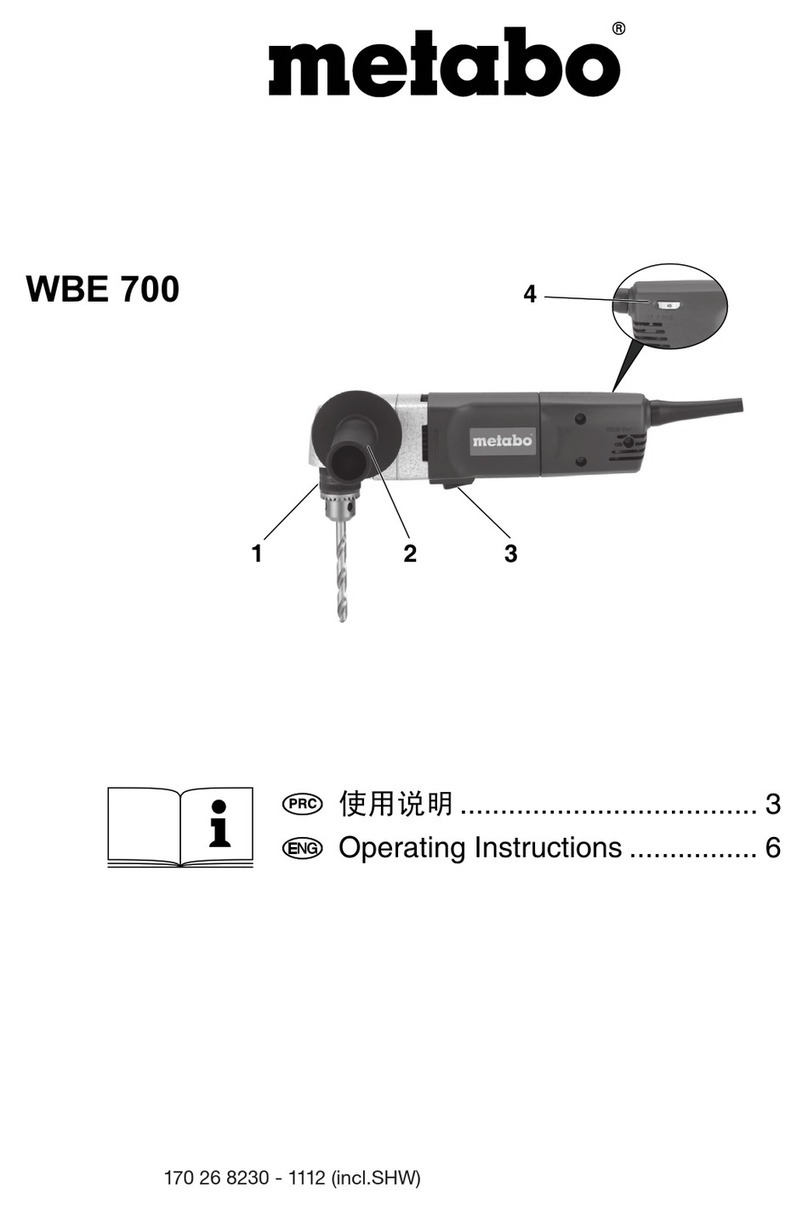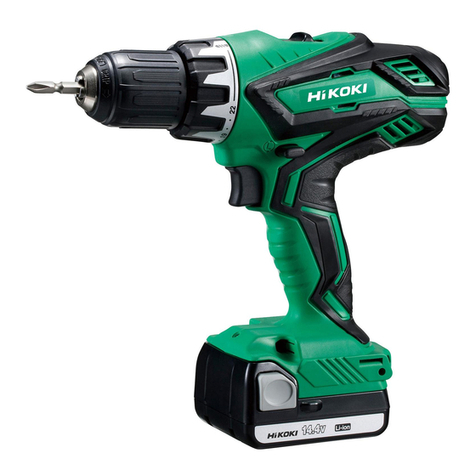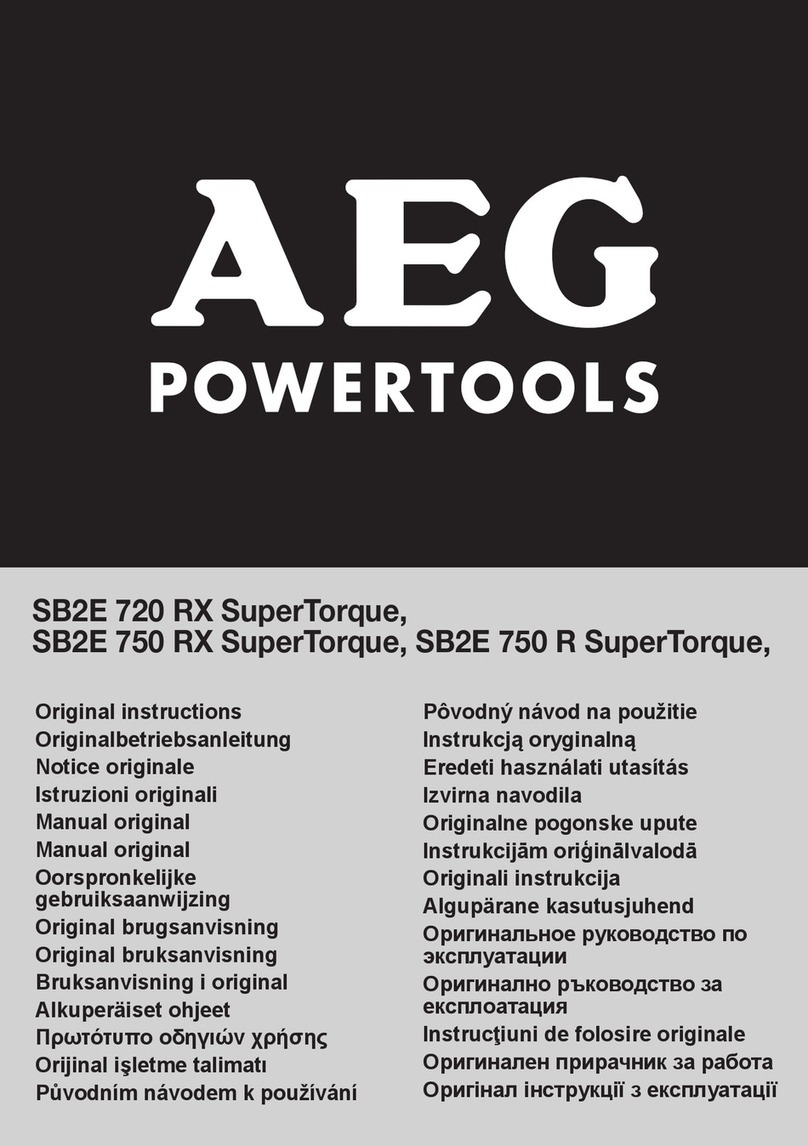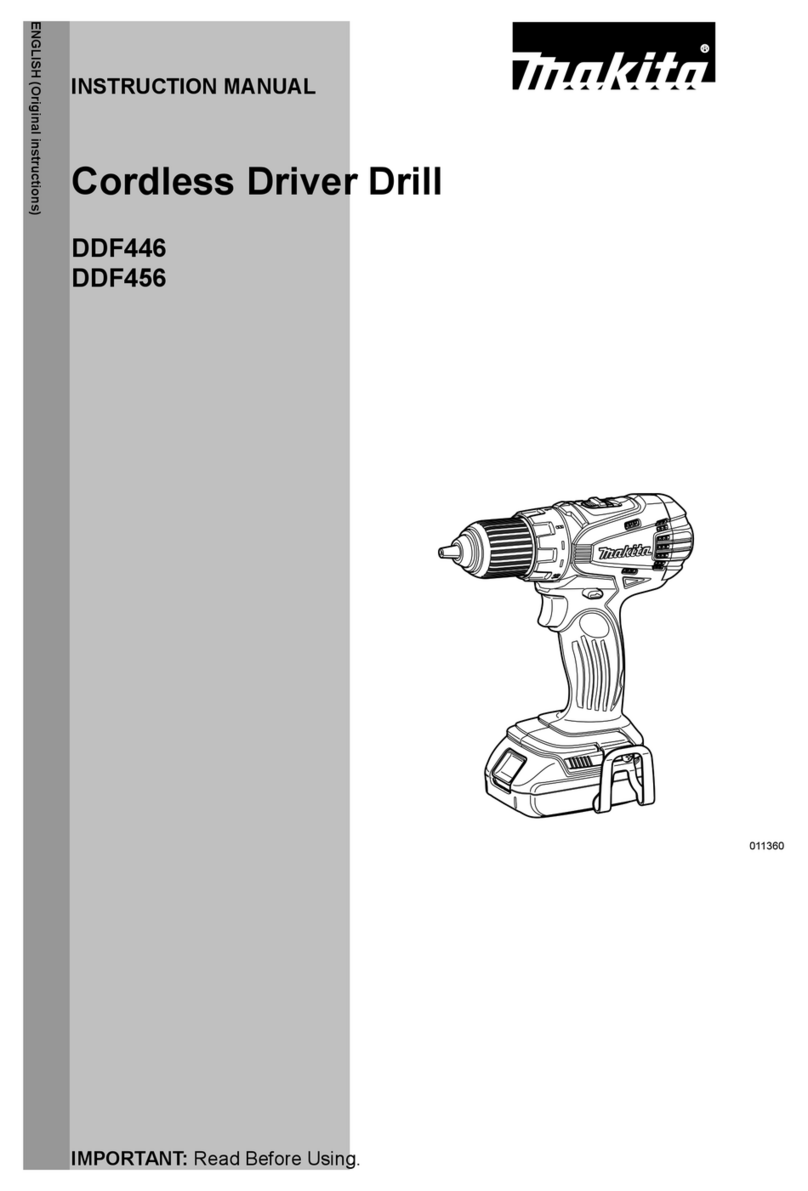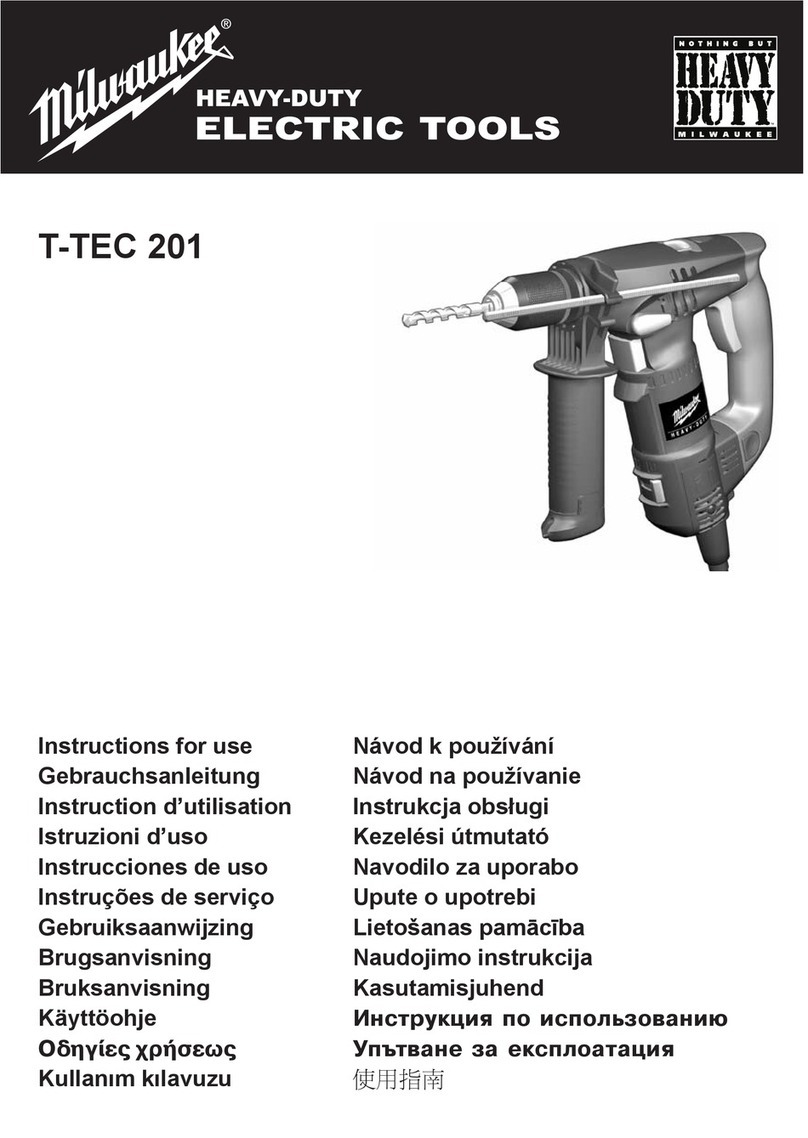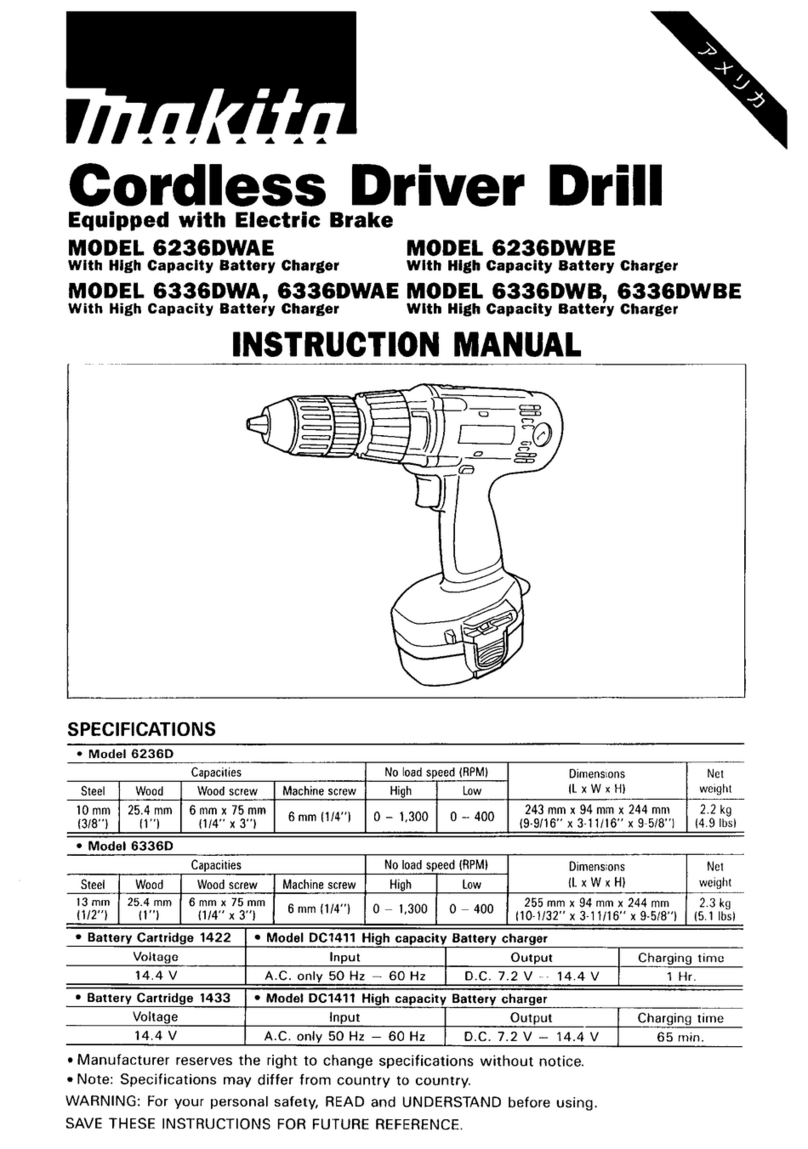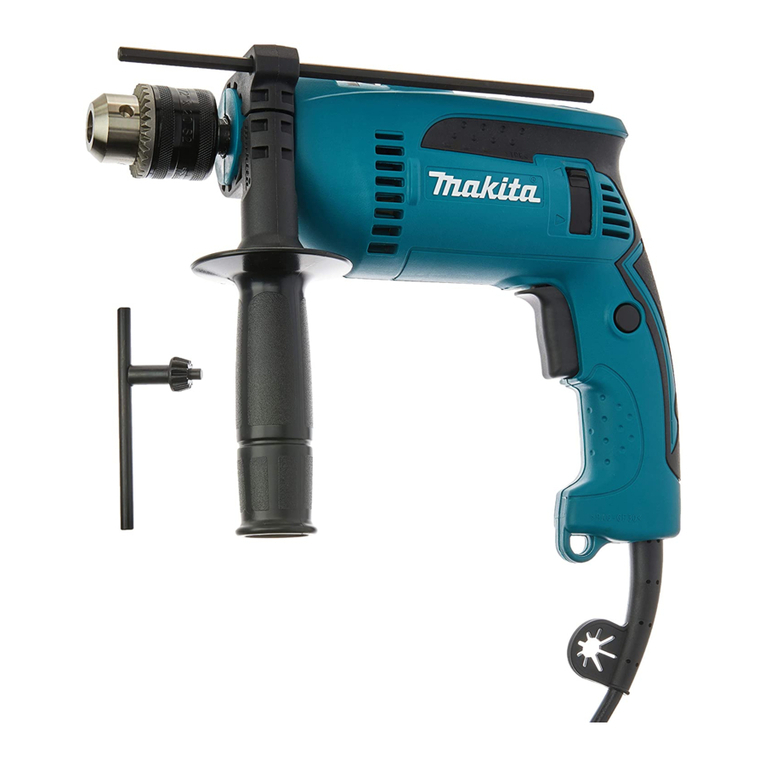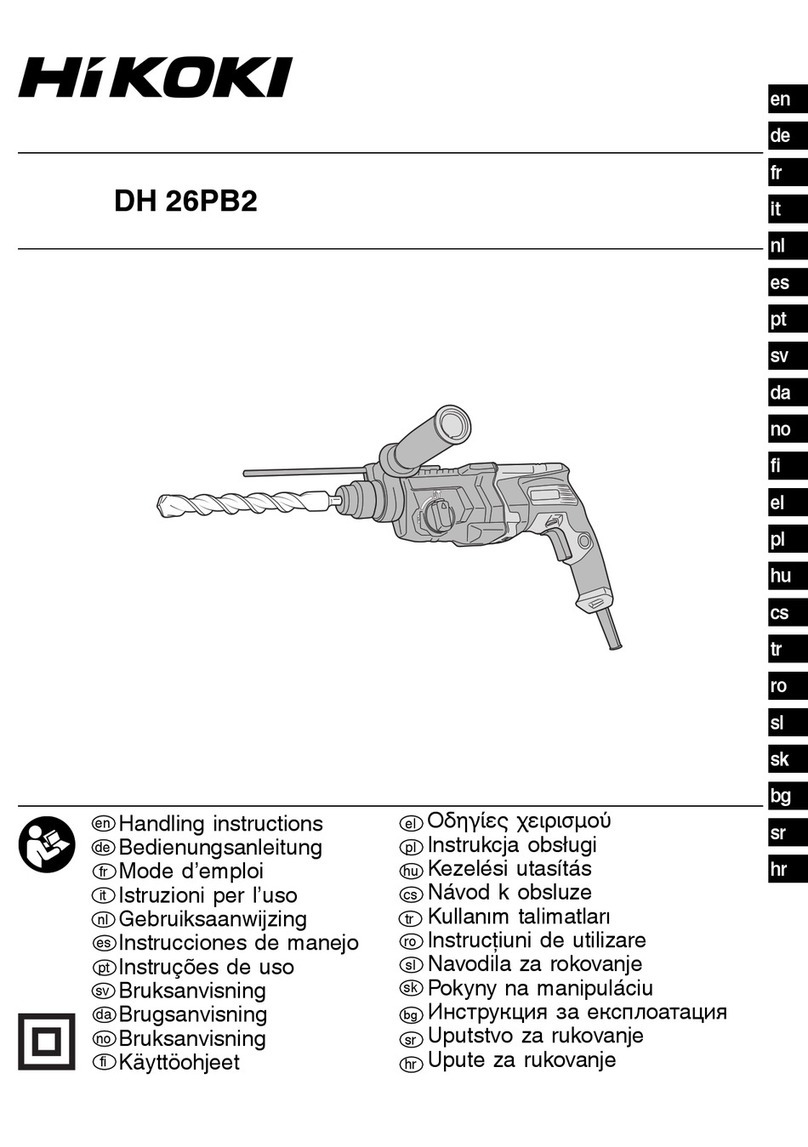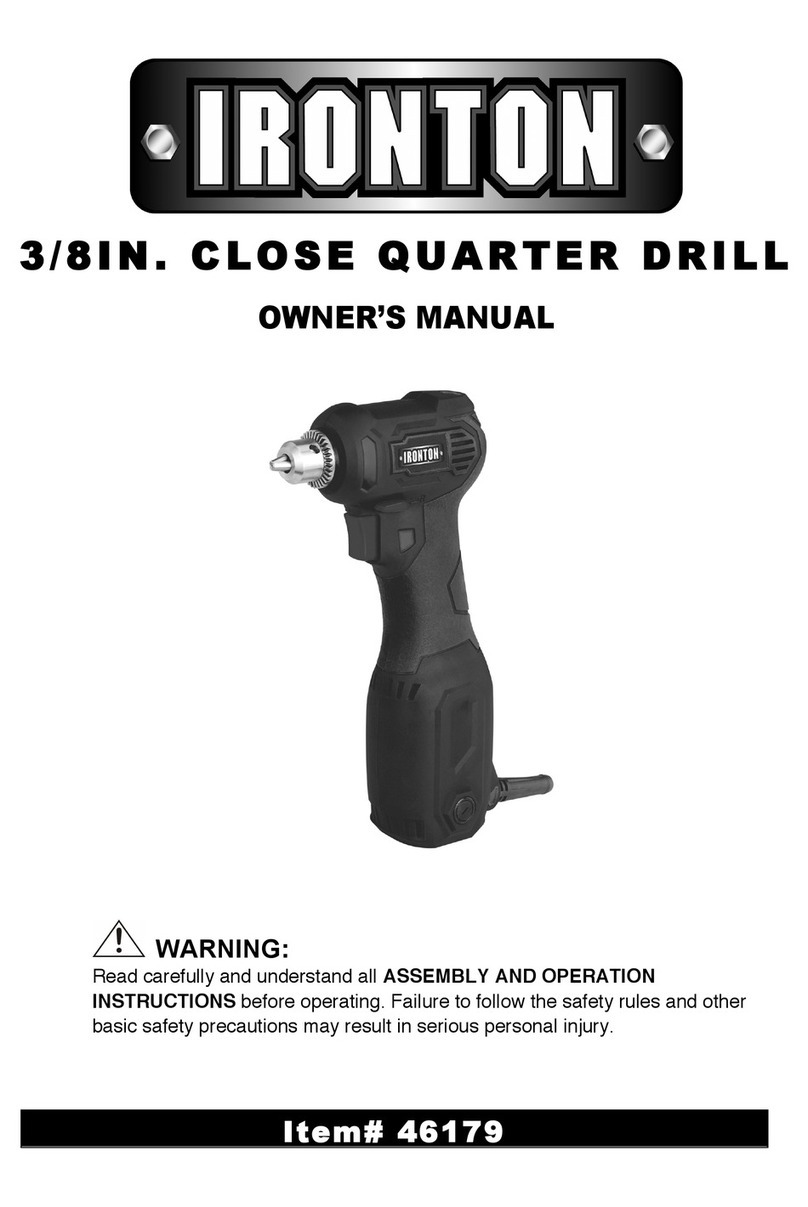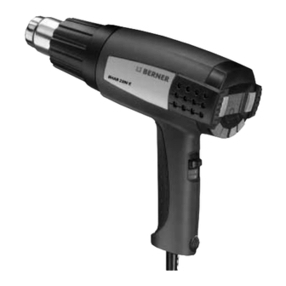ToolPRO CDT218BWG User manual

TOOLPRO
18V DRILL DRIVER
Instruction Manual
Important - Please read these instructions fully before operating or maintaining your drill driver
These instructions contain important information that will help you get the best from your
drill driver, ensuring it remains safe to operate.
If you need help or have damaged or missing parts, call the Customer Helpline on 1300 889 028
After Sales Support
CDT218BWG CDT218BWG.9
FREE CALL 1300 889 028
EMAIL:salesau@positecgroup.com

Customer Helpline 1300 889 028
2
Contents
Safety Information.....................................................................................................3
In The Box...................................................................................................................9
Accessories...............................................................................................................9
OperatingInstructions..............................................................................................10
Trobule Shooting...................................................................................................... 16
Maintenance.............................................................................................................16
Technical Data..........................................................................................................17

Customer Helpline 1300 889 028
3
Safety Information
Important - Please read these instructions fully before starting assembly
Warning Symbols
To reduce the risk of injury, user must read instruction manual
Warning Wear eye protection
Wear ear protection Indoor use only
Wear dust mask Do not burn
Batteries may enter water cycle if disposed improperly, which can be hazardous for
ecosystem. Do not dispose of waste batteries as unsorted municipal waste.
Waste electrical products must not be disposed of with household waste. Please recycle
where facilities exist. Check with your local authorities or retailer for recycling advice.
Li-ion battery. This product has been marked with a symbol relating to ‘separate
collection’ for all battery packs and battery pack. It will then be recycled or
dismantled in order to reduce the impact on the environment. Battery packs can be
hazardous for the environment and for human health since they contain hazardous
substances.
Fuse
Positive terminal
Negative terminal
Read the operator’s manual
Double insulation
RCM marking
ABN: Australian Business Number. By this number, business information such as entity
type, status, business location etc. can be found at website http://abr.business.gov.au.
ABN of Positec Australia Pty Limited is 14 101 682 357
Li-I on Li-Ion

Customer Helpline 1300 889 028
4
WARNING! Read all safety warnings, instructions, illustrations and
specifications provided with this power tool.
Failure to follow the warnings and
instructions may result in electric shock, fire and/or serious injury.
Save all warnings and instructions for future reference.
The term “power tool” in the warnings refers to your mains-operated (corded) power tool
or battery-operated (cordless) power tool.
1) Work area safety
a) Keep work area clean and well lit.
Cluttered or dark areas invite accidents.
b) Do not operate power tools in explosive atmospheres, such as in the presence of
flammable liquids, gases or dust.
Power tools create sparks which may ignite the
dust or fumes.
c) Keep children and bystanders away while operating a power tool.
Distractions can
cause you to lose control.
2) Electrical safety
a) Power tool plugs must match the outlet. Never modify the plug in any way. Do not
use any adapter plugs with earthed (grounded) power tools.
Unmodified plugs and
matching outlets will reduce risk of electric shock.
b) Avoid body contact with earthed or grounded surfaces, such as pipes, radiators,
ranges and refrigerators.
There is an increased risk of electric shock if your body is
earthed or grounded.
c) Do not expose power tools to rain or wet conditions.
Water entering a power tool will
increase the risk of electric shock.
d) Do not abuse the cord. Never use the cord for carrying, pulling or unplugging the
power tool. Keep cord away from heat, oil, sharp edges or moving parts.
Damaged or
entangled cords increase the risk of electric shock.
e) When operating a power tool outdoors, use an extension cord suitable for outdoor
use.
Use of a cord suitable for outdoor use reduces the risk of electric shock.
f) If operating a power tool in a damp location is unavoidable, use a residual
current device (RCD) protected supply.
Use of an RCD reduces the risk of electric
shock.
3) Personal safety
a) Stay alert, watch what you are doing and use common sense when operating a
power tool. Do not use a power tool while you are tired or under the influence of
drugs, alcohol or medication.
A moment of inattention while operating power tools
may result in serious personal injury.
b) Use personal protective equipment. Always wear eye protection.
Protective
equipment such as dust mask, non-skid safety shoes, hard hat, or hearing protection
used for appropriate conditions will reduce personal injuries.
c) Prevent unintentional starting. Ensure the switch is in the off-position before
connecting to power source and/or battery pack, picking up or carrying the tool.
Carrying power tools with your finger on the switch or energising power tools that
Safety Information
Important - Please read these instructions fully before starting assembly
General Power Tool Safety Warnings

Customer Helpline 1300 889 028
5
have the switch on invites accidents.
d) Do not overreach. Keep proper footing and balance at all times.
This enables better
control of the power tool in unexpected situations.
e) Dress properly. Do not wear loose clothing or jewellery. Keep your hair, and
clothing away from moving parts.
Loose clothes, jewellery or long hair can be caught
in moving parts.
f) If devices are provided for the connection of dust extraction and collection facilities,
ensure these are connected and properly used.
Use of dust collection can reduce
dust-related hazards.
g) Do not let familiarity gained from frequent use of tools allow you to become
complacent and ignore tool safety principles.
A careless action can cause severe
injury within a fraction of a second.
4) Power tool use and care
a) Do not force the power tool. Use the correct power tool for your application.
The correct power tool will do the job better and safer at the rate for which it was
designed.
b) Do not use the power tool if the switch does not turn it on and off.
Any power tool
that cannot be controlled with the switch is dangerous and must be repaired.
c) Disconnect the plug from the power source and/or remove the battery pack,
if detachable, from the power tool before making any adjustments, changing
accessories, or storing power tools.
Such preventive safety measures reduce the
risk of starting the power tool accidentally.
d) Store idle power tools out of the reach of children and do not allow persons
unfamiliar with the power tool or these instructions to operate the power tool.
Power tools are dangerous in the hands of untrained users.
e) Maintain power tools and accessories. Check for misalignment or binding of moving
parts, breakage of parts and any other condition that may affect the power tool’s
operation. If damaged, have the power tool repaired before use.
Many accidents are
caused by poorly maintained power tools.
f) Use the power tool, accessories and tool bits etc. in accordance with these
instructions, taking into account the working conditions and the work to be
performed.
Use of the power tool for operations different from those intended could
result in a hazardous situation.
g) Keep handles and grasping surfaces dry, clean and free from oil and grease.
Slippery handles and grasping surfaces do not allow for safe handling and control of
the tool in unexpected situations.
5) Battery tool use and care
a) Recharge only with the charger specified by the manufacturer.
A charger that is
suitable for one type of battery pack may create a risk of fire when used with another
battery pack.
b) Use power tools only with specifically designated battery packs.
Use of any other
battery packs may create a risk of injury and fire.
c) When battery pack is not in use, keep it away from other metal objects, like paper
Safety Information
Important - Please read these instructions fully before starting assembly
General Power Tool Safety Warnings

Customer Helpline 1300 889 028
6
clips, coins, keys, nails, screws or other small metal objects, that can make a
connection from one terminal to another.
Shorting the battery terminals together may
cause burns or a fire.
d) Under abusive conditions, liquid may be ejected from the battery; avoid contact.
If
contact accidentally occurs, flush with water. If liquid contacts eyes, additionally seek
medical help. Liquid ejected from the battery may cause irritation or burns.
e) Do not use a battery pack or tool that is damaged or modified.
Damaged or modified
batteries may exhibit unpredictable behaviour resulting in fire, explosion or risk of
injury.
f) Do not expose a battery pack or tool to fire or excessive temperature.
Exposure to
fire or temperature above 130 °C may cause explosion.
g) Follow all charging instructions and do not charge the battery pack or tool outside
the temperature range specified in the instructions.
Charging improperly or at
temperatures outside the specified range may damage the battery and increase the
risk of fire.
6) Service
a) Have your power tool serviced by a qualified repair person using only identical
replacement parts.
This will ensure that the safety of the power tool is maintained.
b) Never service damaged battery packs.
Service of battery packs should only be
performed by the manufacturer or authorized service providers.
Safety Information
Important - Please read these instructions fully before starting assembly
General Power Tool Safety Warnings
1) Safety instructions for all operations
a) Hold the power tool by insulated gripping surfaces, when performing an operation
where the cutting accessory or fasteners may contact hidden wiring.
Cutting
accessory or fasteners contacting a “live” wire may make exposed metal parts of the
power tool “live” and could give the operator an electric shock.
2) Safety instructions when using long drill bits
a) Never operate at higher speed than the maximum speed rating of the drill bit.
At
higher speeds, the bit is likely to bend if allowed to rotate freely without contacting the
workpiece, resulting in personal injury.
b) Always start drilling at low speed and with the bit tip in contact with the workpiece.
At higher speeds, the bit is likely to bend if allowed to rotate freely without contacting
the workpiece, resulting in personal injury.
c) Apply pressure only in direct line with the bit and do not apply excessive pressure.
Bits can bend causing breakage or loss of control, resulting in personal injury.
Drill Safety Warning

Customer Helpline 1300 889 028
7
Safety Information
Important - Please read these instructions fully before starting assembly
Safety Warnings for battery pack
a) Do not dismantle, open or shred cells or battery pack.
b) Do not short-circuit a battery pack. Do not store battery packs haphazardly in a
box or drawer where they may short-circuit each other or be short-circuited by
conductive materials. When battery pack is not in use, keep it away from other metal
objects, like paper clips, coins, keys, nails, screws or other small metal objects, that
can make a connection from one terminal to another. Shorting the battery terminals
together may cause burns or a fire.
c) Do not expose battery pack to heat or fire. Avoid storage in direct sunlight.
d) Do not subject battery pack to mechanical shock.
e) In the event of battery leaking, do not allow the liquid to come into contact with the
skin or eyes. If contact has been made, wash the affected area with copious amounts
of water and seek medical advice.
f) Seek medical advice immediately if a cell or battery pack has been swallowed.
g) Keep battery pack clean and dry.
h) Wipe the battery pack terminals with a clean dry cloth if they become dirty.
i) Battery pack needs to be charged before use. Always refer to this instruction and
use the correct charging procedure.
j) Do not maintain battery pack on charge when not in use.
k) After extended periods of storage, it may be necessary to charge and discharge the
battery pack several times to obtain maximum performance.
l) Battery pack gives its best performance when it is operated at normal room
temperature (20 °C ± 5 °C).
m) When disposing of battery packs, keep battery packs of different electrochemical
systems separate from each other.
n) Recharge only with the charger specified by manufacturer. Do not use any charger other
than that specifically provided for use with the equipment. A charger that is suitable for
one type of battery pack may create a risk of fire when used with another battery pack.
o) Do not use any battery pack which is not designed for use with the equipment.
p) Keep battery pack out of the reach of children.
q) Retain the original product literature for future reference.
r) Remove the battery from the equipment when not in use.
s) Dispose of properly.
t) Do not mix cells of different manufacture, capacity, size or type within a device.
u) Do not remove battery pack from its original packaging until required for use.
v) Observe the plus (+) and minus (–) marks on the battery and ensure correct use.

Customer Helpline 1300 889 028
8
Safety Information
WARNING: Read all safety warnings and all instructions. Failure to follow the
warnings and instructions may result in electric shock, fire and/or serious injury.
Save all warnings and instructions for future reference.
- This appliance is not intended for use by persons (including children) with reduced
physical, sensory or mental capabilities, or lack of experience and knowledge, unless they
have been given supervision or instruction concerning use of the appliance by a person
responsible for their safety.
- Children should be supervised to ensure that they do not play with the appliance.
If the supply cord is damaged, it must be replaced by the manufacturer, its service agent or
similarly qualified persons in order to avoid a hazard.
Additional safety instructions for your Battery Charger
1. Before charging, read the instructions.
2. For charge Li-ion battery pack only.
3. Do not charge a leaking battery.
4. Do not use chargers for works other than those for which they are designed.
5. Before charging, ensure your charger is matching the local AC supply.
6. The charging device must be protected from moisture.
7. Do not use the charging device outdoors.
8. Do not short out the contacts of battery or charger.
9. Respect the polarity “+/-“ when charging.
10.Do not open the unit and keep it out of the reach of children.
11.Do not charge the batteries of other manufactures or ill-suited models.
12.Ensure that the connection between the battery charger and battery is correctly
positioned and is not obstructed by foreign bodies.
13.Keep battery charger’s slots free of foreign objects and protect against dirt and
humidity. Store in a dry and frost-free place.
14.When charging batteries, ensure that the battery charger is in a well-ventilated area
and away from inflammable materials. Batteries can get hot during charging. Do not
overcharge any batteries. Ensure that batteries and chargers are not left unsupervised
during charging.
15.Do not recharge non-rechargeable batteries, as they can overheat and break.
16.Longer life and better performance can be obtained if the battery pack is charged
when the air temperature is between 18oC and 24oC. Do not charge the battery pack in
air temperatures below 0oC , or above 40oC . This is important as it can prevent serious
damage to the battery pack.
17.Charge only battery pack of the same model provided by manufacturer and of models
recommended by manufacturer.
Important - Please read these instructions fully before starting assembly
GeneralSafety Warnings

Customer Helpline 1300 889 028
9
In The Box
Parts
1
5
2
3
6
7
9
10
11
8
4
Keyless Chuck
Torque Adjustment Ring
Two-speed Gear Control
Forward/Reverse Rotation Control
Soft Grip Handle
Belt Clip
Battery Pack
Battery Pack Release Button
LED light
On/Off Switch
Battery Capacity Indicator
Accessories
CDT218BWG CDT218BWG.9
Battery Pack 1 /
Charger 1 /
Belt Clip 1 1
23
4
5
6
7
9
11
10
8
1

Customer Helpline 1300 889 028
10
Operating Instructions
NOTE: Before using the tool, read the instruction book carefully.
Intended Use
This tool is intended for the fastening and loosening of bolts, nuts and various threaded fasteners.
This tool is not intended for use as a drill.
BEFORE PUTTING INTO OPERATION
1. CHARGER
A) CHARGING THE BATTERY (SEE FIG. A1&A2&A3)
a) The battery in your new tool is not charged when it leaves the plant. Therefore it must be
full charged before using the first time.
b) Do not use any charger other than that specifically provided for use with the equipment.
c) If the battery pack is very hot you must remove your battery pack from the charger and
allow time for the battery to cool down before recharging.
d) Please charge the battery to reach full or no less than half charge before storage. If the
tool will not be used for long periods of time, charge the battery every 3-6 months.
B) CHARGING PROCEDURE
1) Plug the charger into an appropriate outlet. The light will be green.
2) Slide the battery pack into the charger, make sure the battery is in the correct charge
position firmly. The light will turn to red to indicate the charging process has started.
3) When charging is completed, the light will turn to green.
4) When fully charged, unplug the charger and remove the battery pack.
Note: If the battery pack is locked in the charger, press the battery pack release button
and remove it.
WARNING: When battery charge runs out after continuous use or exposure to
direct sunlight or heat, allow time for the tool to cool down before re-charging to
achieve the full charge.

Customer Helpline 1300 889 028
11
Operating Instructions
C) CHARGING INDICATOR
This charger is designed to detect some problems that can arise with battery packs.
Indicator lights indicate problems (see table below). If this occurs, insert a new battery pack
to determine if the charger is OK. If the new battery charges correctly, then the original
pack is defective and should be returned to a service center or recycling service center.
If the new battery pack displays the same problem as the original battery pack, have the
charger tested at an authorized service center.
Light ON/OFF flash Status
Red on Charging
Red flash - - - - - Defective Battery
Green on Fully Charged
Green flash - - - - - - Hot/Cold Delay
A1
A3
A2
Green Light Red Light

Customer Helpline 1300 889 028
12
Operating Instructions
2. REMOVE OR INSERT BATTERY PACK (SEE FIG. B,C)
Press the battery pack release button and remove the battery pack from the tool. After
recharge slide the battery pack into tool’s battery port. A simple push and slight pressure
will be sufficient.
OPERATION
1. ON / OFF SWITCH (SEE FIG. D)
Depress the On/Off switch to start and release it to stop your drill.
The on/off switch is fitted with a brake function which stops your chuck immediately when
you quickly release the switch.
It is also a variable speed switch that delivers higher speed and torque with increased
trigger pressure. Speed is controlled by the amount of On/Off switch depression.
WARNING: Do not operate for long periods at low speed because excess heat will be
produced internally. When overload occurs, release the On/Off switch immediately
to avoid the motor overheating.
2. SWITCH LOCK (SEE FIG. E)
The On/Off switch can be locked in the OFF position. This helps to reduce the possibility of
accidental starting when not in use. To lock the On/Off switch, place the rotation control in
the center position.
1
2
CLOSE
OPEN
1
2
D E
F1 F2
G H
I J
B C
1
2
CLOSE
OPEN
1
2
D E
F1 F2
G H
I J
B C

Customer Helpline 1300 889 028
13
Operating Instructions
3. REVERSIBLE (SEE FIG. F1, F2)
Forward rotating: push the forward/reverse rotation control to the left (the drill points
away from you). It is used for drilling and screw driving.
Reverse rotation: push the forward/reverse rotation control to the right (the drill points
away from you). It is used for remove screws or release a jammed drill bit.
WARNING: Never change the direction of rotation when the chuck is rotating, wait
until it has stopped!
4. TWO-SPEED GEAR CONTROL (SEE FIG. G)
The drill has a two-speed gear control designed for drilling or driving at LO (mark is 1) or
HI (mark is 2) speeds. A slide switch is located on top of the drill to select either LO or HI
speed. When using the drill in the LO speed range, the speed will decrease and the drill
will have greater power and torque. When using the drill in the HI speed range, the speed
will increase and the drill will have less power and torque.
Gear I
Low speed range: for screwdriving or working Large diameter drill.
Gear II
High speed range: for working with small diameter drill.
WARNING: To prevent gear damage, always allow the chuck to come to a
complete stop before changing the direction of rotation or the two-speed gear
control.
When overload occurs frequently on the high speed gear, switch to the low speed gear
to avoid the motor overheating.
5. CHUCK ADJUSTMENT (SEE FIG. H)
To open the chuck jaws rotate the front section of the chuck. Insert the drill bit between
the chuck jaws and rotate the front section in the opposite direction. Ensure the drill
bit is in the center of the chuck jaws. Finally, firmly rotate the front chuck section in the
opposite directions. Your drill bit is now clamped in the chuck.
1
2
CLOSE
OPEN
1
2
D E
F1 F2
G H
I J
B C

Customer Helpline 1300 889 028
14
Operating Instructions
6. TORQUE ADJUSTMENT (SEE FIG I)
The torque is adjusted by rotating the torque adjustment ring. The torque is greater when
the torque adjustment ring is set on a higher setting. The torque is less when the torque
adjustment ring is set on a lower setting.
Make the setting as follows:
1 - 4 for driving small screws
5 - 9 for driving screws into soft material
10 - 18 for driving screws into soft and hard material
for heavy drilling
7. BELT CLIP (SEE FIG. J)
Screw the belt clip on the tool with the screw provided in the plastic bag. The belt clip can
be hooked on your belt or pocket, etc.
1
2
CLOSE
OPEN
1
2
D E
F1 F2
G H
I J
B C
1
2
CLOSE
OPEN
1
2
D E
F1 F2
G H
I J
B C

Customer Helpline 1300 889 028
15
Operating Instructions
8. USING THE SIGHT LIGHT
To turn on the light, press the on/off switch and make sure the forward/reverse rotation
control is on right/left position. When you release the on/off switch, the light will be off.
LED lighting increases visibility-great for dark or enclosed area.
LED is also a battery capacity indicator. It will flash when power gets low.
9. BATTERY CAPACITY INDICATOR
Your tool is equipped with battery capacity indicator. Press the on/off switch halfway or
fully, the battery capacity indicator will light up to show the amount of charge left in the
battery.
Fuel Gauge Capacity
3 lights >70%
2 lights 40%~70%
1 light <40%
10. DRILLING
When drilling into a hard smooth surface, use a center punch to mark the desired hole
location. This will prevent the drill bit from slipping off center as the hole is started.
Hold the tool firmly and place the tip of the bit at the point to be drilled.
Depress the on/off switch to start the tool.
Move the drill bit into the workpiece, applying only enough pressure to keep the bit
cutting. Do not force or apply side pressure to elongate a hole.
WARNING: Tungsten carbide drill bits should always be used for concrete and
masonry. When drilling in metal, only use HSS drill bits in good condition. Always
use a magnetic bit holder (not included) when using short screwdriver bits. When
screw-driving, apply a small quantity of liquid soap or similar to the screw threads to
ease insertion.
11. OVERLOAD PROTECTION
When overloaded, the motor comes to a stop. Relieve the load on the machine
immediately and allow cooling for approx. 30 seconds at the highest no-load speed.
12. TEMPERATURE DEPENDENT OVERLOAD PROTECTION
When using as intended for the power tool cannot be subject to overload. When the load
is too high or the allowable battery temperature of 75°C is exceeded, the electronic
control switches off the power tool until the temperature is in the optimum temperature
range again.
13. PROTECTION AGAINST DEEP DISCHARGING
The Li-ion battery is protected against deep discharging by the “Discharging Protection
System”. When the battery is empty, the machine is switched off by means of a protective
circuit: The drill will no longer rotate. Remove the battery and recharge.

Customer Helpline 1300 889 028
16
Trouble Shooting
Maintenance
Remove the battery pack from the tool before carrying out any adjustment, servicing
or maintenance.
Your tool requires no additional lubrication or maintenance.
There are no user serviceable parts in your power tool. Never use water or chemical
cleaners to clean your power tool. Wipe clean with a dry cloth. Always store your power
tool in a dry place. Keep the motor ventilation slots clean. Keep all working controls free
of dust. Occasionally you may see sparks through the ventilation slots. This is normal
and will not damage your power tool.
For Battery tools
The ambient temperature range for the use and storage of tool and battery is 0oC-45oC.
The recommended ambient temperature range for the charging system during charging
is 0oC-40oC.
1. WHY DOES THE DRILL NOT TURN ON WHEN YOU PRESS THE SWITCH?
The forward/reverse rotation control, which is on top of the on/off switch, is positioned
in the lock function. Unlock the forward/reverse rotation control by putting it into the
required rotation position. Push the on/off switch and the drill will start to rotate.
2. THE DRILL STOPS BEFORE THE SCREW IS COMPLETELY TIGHTENED. WHY?
Verify the torque position of the torque adjusting ring, you can find the torque-adjusting
ring between the chuck and the drill body. Position 1 is the lowest torque (screw driving
force) and position 18 is the highest torque (screw driving force). Position is for drill
operation.
3. REASONS FOR DIFFERENT BATTERY PACK WORKING TIMES
Charging time problems and having not used a battery pack for a prolonged time will
reduce the battery pack working time. This can be corrected after several charge and
discharge operations by charging & working with your drill. Heavy working conditions
such as large screws into hard wood will use up the battery pack energy faster than
lighter working conditions. Do not re-charge your battery pack below 0oC and above 40oC
as this will affect performance.

Customer Helpline 1300 889 028
17
Technical Data
Type: CDT218BWG CDT218BWG.9 (CDT -designation of machinery, representative of Drill)
CDT218BWG CDT218BWG.9
Voltage 18V
No load speed 0-500/0-2000 /min
Number of clutch positions 18+1
Max torque 60N.m
Chuck capacity 13mm
Max. drilling
capacity
Steel 13mm
Wood 40mm
Machine weight 1.6Kg (Including battery)
1.24Kg (Bare tool)
Charger Input (ACG1830D) 100-240V~50/60Hz /
Charger Output (ACG1830D) 14.4-20V 3.0A /
Charger Protection class / II /
Battery capacity
(ABP1815SG) 1.5Ah Li-ion battery /
Charging time 30 mins /
Technical Data Table
Staple your purchase receipt here
Before returning this product for
warranty or any other reason, please call.
Manufactured and packaged for SRGS PTY LTD
ABN 23 113 230 050
6 Coulthards Avenue Strathpine QLD 4500, Australia
FREE CALL 1300 889 028
EMAIL:sales[email protected]



This manual suits for next models
1
Table of contents
Other ToolPRO Drill manuals

